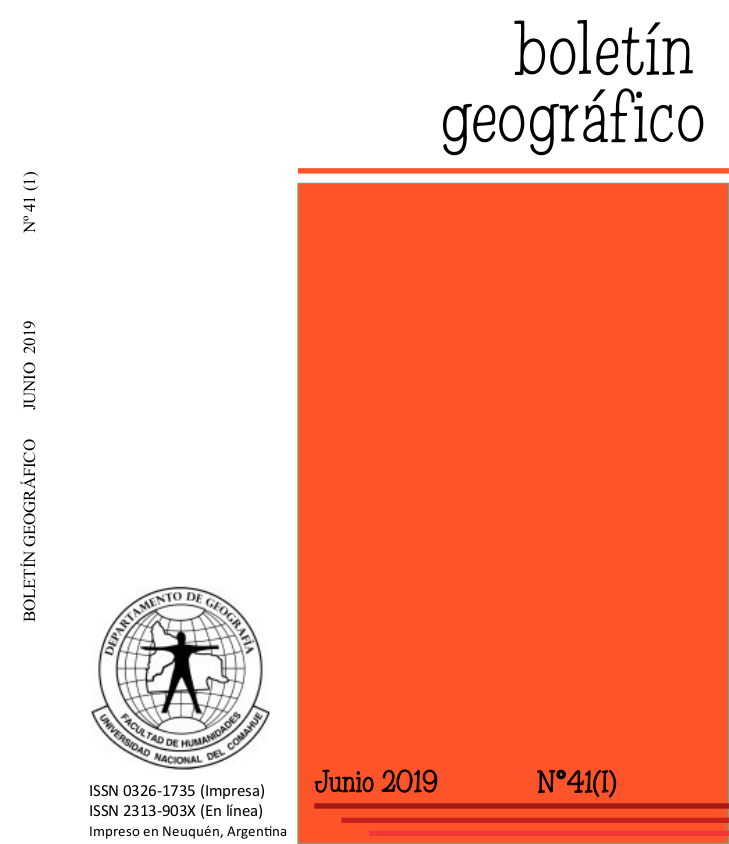Impacts of climatic variability on the vegetation of the Sauce Grande river basin (Argentina)
Keywords:
NDVI, SPEI, tendencia, sequía, actividad agropecuariaAbstract
Climate change has had profound impacts on terrestrial ecosystems, vegetation being one of the most affected elements. The objective of this work was to analyze the impacts of climate variability on the vegetation of the Sauce Grande river basin (Argentina) by applying the standardized precipitation and evapotranspiration index (SPEI) and the vegetation index of normalized difference (NDVI). The methodology included analyzing three-point data from the February and October NDVI and the two-month SPEI during the 2000-2020 period. A Pearson correlation was applied between both indices, and the trend and variations were calculated from the Mann Kendall test and the Sen slope estimator, respectively. The results indicated that the two-month SPEI scale (SPEI-2) was the most appropriate to analyze the dynamics of the vegetation of the study area since the correlation coefficient was higher than 0.782 with a high degree of statistical significance (p <0.01) in the three sectors of the basin. During the 2000-2020 period, the SPEI-2 presented a negative and statistically significant trend throughout the study area. Therefore, there was an increase in the frequency of dry periods and an increase in the magnitude of these events, increasing in the N-S direction during February and the opposite during October. The NDVI for February and October also presented a negative trend and statistical significance throughout the basin. This situation indicated that the vegetation presented deterioration processes as a consequence of the increase in dry periods. The lower basin was the one that reflected the most critical deterioration processes since the February NDVI presented a decrease rate of -0.032, while that of October was -0.044 in the 21 years analyzed. The results were found to provide essential information for decision-makers and agricultural producers since it will serve as a basis for planning agroeconomic activities, land use planning, and guiding public policies to conserve the natural resources of the Sauce Grande river basin.
Downloads
References
Álvarez, C. &Basanta, M. (2015). Manejo sustentable de sistemas agrícolas en la región central de Córdoba: una experiencia de largo plazo en INTA EEA Manfredi. Revista de Investigaciones Agropecuarias, 41(2), 215-222
Arnaudo, M.F. & Corbella, V. (2013). Análisis de la potencialidad de monte hermoso para lograr el desarrollo local a partir de bienes culturales. Revista de Investigación en Turismo y Desarrollo Local,6(15), 1-11.
Barragán, F., Marini, F., Ángeles, G. & Garabito, C. (2016). Determinación del uso del suelo en una zona semiárida mediante un estudio multitemporal con imágenes Landsat. Congreso Nacional de Tecnologías de la Información Geográfica y II Jornadas de Sistemas de Información Geográfica. Universidad Nacional de General Sarmiento, Buenos Aires.
Beguería, S., Vicente-Serrano, S.M. & Angulo-Martínez, M. (2010). A multiscalar global drought dataset: the SPEIbase: a new gridded product for the analysis of drought variability and impacts.Bulletin of the American Meteorological Society,91(10), 1351-1354.
Brendel, A.S., Bohn, V.Y. & Piccolo, M.C. (2017). Variabilidad de la precipitación y su relación con los rendimientos agrícolas en una región semiárida de la llanura pampeana (Argentina). Estudios Geográficos,78, 7-29.
Brendel, A.S., Ferrelli, F., Piccolo, M. C. & Perillo, G. M. (2019). Assessment of theeffectiveness of supervised and unsupervised methods: maximizing land-cover classification accuracy with spectral indices data.Journal of Applied Remote Sensing,13(1), 014503.
Brendel, A.S. (2020). Estudio integral de los recursos hídricos y las coberturas del suelo de la cuenca media y baja del río Sauce Grande (Argentina) (Tesis Doctoral). Universidad Nacional del Sur, Bahía Blanca.
Brendel, A.S., Ferrelli, F., Piccolo, M.C. & Perillo, G.M.E. (2020). Vulnerabilidad eco-ambiental y estrategias de manejo sustentable del territorio: el caso de la cuenca del río Sauce Grande (Argentina). Anales de Geografía de la Universidad Complutense,40(2), 299-322.
Carrascal Leal, C.C., Denegri, G.A. & Delgado, M.I. (2013). Costos mínimos de compensación y cuantificación de la oferta hídrica en la cuenca alta del río SauceGrande, Argentina.Investigaciones Geográficas, Boletín del Instituto deGeografía,80, 55-70.
Casado, A., Peiry, J. L. & Campo, A.M. (2016). Geomorphic and vegetation changes in a meandering dryland river regulated by a large dam, Sauce Grande River, Argentina.Geomorphology,268, 21-34.
Dai, A. (2011). Drought under global warming: a review.Wiley Interdisciplinary Reviews: Climate Change,2(1), 45-65.
Denegri, G.A. & Gaspari, F.J. (2010). Lineamientos para la formulación de pagos por servicios ambientales. Estudio de caso: Alta cuenca del Río Sauce Grande. Argentina.Cuadernos Geográficos, 46, 93-110.
Duval, V.S., Benedetti, G.M. & Campo, A.M. (2015). Relación clima-vegetación: adaptaciones de la comunidad del jarillal al clima semiárido, Parque Nacional Lihué Calel, provincia de La Pampa, Argentina. Investigaciones geográficas, 88, 33-44.
Ferrelli, F., Bohn, V.Y. & Piccolo, M.C. (2011). Aplicación de geotecnologías al estudio de las precipitaciones y su relación con las coberturas del suelo (Pcia. de Buenos Aires, Argentina). GeoFocus. Revista Internacional de Ciencia y Tecnología de la Información Geográfica, 11, 355-374.
Ferrelli, F., Bustos, M.L., Piccolo, M.C., Cisneros, M.A.H. & Perillo, G.M.E. (2016). Downscaling de variables climáticas a partir del reanálisis NCEP/NCAR en el sudoeste de la provincia de Buenos Aires (Argentina). Papeles de Geografía, 62, 21-33.
Ferrelli, F. (2016). Efectos de eventos El Niño y La Niña sobre las lagunas del sur de la Región Pampeana (Argentina). InterEspaço: Revista de Geografia e Interdisciplinaridade, 122-142.
Ferrelli, F. (2017). Variabilidad pluviométrica y sus efectos sobre las coberturas del suelo al sur de la provincia de Buenos Aires, Argentina. Revista Geográfica Venezolana, 58(1), 26-37.
Ferrelli, F., Brendel, A.S., Aliaga, V.S., Piccolo, M.C. & Perillo, G.M.E. (2019). Climate regionalization and trends based on daily temperature and precipitation extremes in the south of the Pampas (Argentina). Cuadernos de Investigación Geográfica, 45(1), 393-416.
Ferrelli, F., Brendel, A.S., Piccolo, M.C. & Perillo, GM.E. (2020). Evaluación de eventos secos y húmedos en el contexto del cambio climático: El caso del sur de la Región Pampeana (Argentina).Papeles de Geografía, 66, 27-46
Guerschman, J.P., Paruelo, J. M., Bella, C.D., Giallorenzi, M. C. & Pacin, F. (2003). Land cover classification in the Argentine Pampas using multi-temporal Landsat TM data. International Journal of Remote Sensing,24(17), 3381-3402.
Hernandez, E.A. & Uddameri, V. (2014). Standardized precipitation evaporation index (SPEI)-based drought assessment in semi-arid south Texas.Environmental Earth Sciences,71(6), 2491-2501.
Hunt, E.D., Svoboda, M., Wardlow, B., Hubbard, K., Hayes, M. & Arkebauer, T. (2014). Monitoring the effects of rapid onset of drought on non-irrigated maize with agronomic data and climate-based drought indices. Agricultural and Forest Meteorology, 191, 1-11.
Intergovernmental Panel on Climate Change (2013): Climate change 2013: the physical science basis. In Contribution of Working Group I to the Fifth Assessment Report of the Intergovernmental Panel on Climate Change. En: Stocker, T.F, Qin, D., Plat-Tner, G-K., Tignor, M., Allen, S.K., Boschung, J., Nauels, A., Xia, Y., Bex, V. Y Midgley, P.M., (Eds), Cambridge University Press, Cambridge, 203 pp.
Jiang, W., Wang, L., Feng, L., Zhang, M. & Yao, R. (2020). Drought characteristics and its impact on changes in surface vegetation from 1981 to 2015 in the Yangtze River Basin, China. International Journal of Climatology, 40(7), 3380-3397.
Justice, C.O., Townshend, J.R.G., Vermote, E.F., Masuoka, E., Wolfe, R.E., Saleous, N. & Morisette, J.T. (2002). An overview of MODIS Land data processing and product status. Remote sensing of Environment, 83(1-2), 3-15.
Kendall, M.G. (1948). Rank correlation methods, London, Griffin.
Lara, B., Gandini, M., Gantes, P. & Matteucci, S.D. (2018). Regional patterns of ecosystem functional diversity in the Argentina Pampas using MODIS time-series. Ecological Informatics, 43, 65-72.
Li, F., Zhao, W. & Liu, H. (2013). The response of aboveground net primary productivity of desert vegetation to rainfall pulse in the temperate desert region of northwest China. PLoS One,8(9), e73003.
Liu, Z., Wang, Y., Shao, M., Jia, X. & Li, X. (2016). Spatiotemporal analysis of multiscalar drought characteristics across the Loess Plateau of China.Journal of Hydrology. 534, 281-299.
Liu, L., Wang, Y., Wang, Z., Li, D., Zhang, Y., Qin, D. & Li, S. (2019). Elevation-dependent decline in vegetation greening rate driven by increasing dryness based on three satelliteNDVI datasets on the Tibetan Plateau.Ecological Indicators,107, 105569.
Luo, N., Mao, D., Wen, B. & Liu, X. (2020). Climate Change Affected Vegetation Dynamics in the Northern Xinjiang of China: Evaluation by SPEI and NDVI.Land,9(3), 90.
Mann, H.B. (1945). Non-parametric tests against trend, Econométrica, 13.
Mathbout, S., Lopez-Bustins, J.A., Martin-Vide, J., Bech, J. & Rodrigo, F.S. (2018). Spatial and temporal analysis of drought variability at several time scales in Syria during 1961–2012. Atmospheric Research, 200, 153-168.
Millano-Tudare, J.L., Paredes-Trejo, F.J., Jaimes, E., Pineda, N., Mendoza, J. G., Garcés, Y. & Pineda, I. (2017). Patrones fenológicos de cinco tipos de cobertura enbosque seco tropical, sur-cojedes, Venezuela. Revista Agrollania de Ciencia y Tecnología, 14, 106-112.
Plataforma Intergubernamental de Política Científica en Biodiversidad y Servicios de los Ecosistemas (IPBES). (2019). Summary for policymakers of the global assessment report on biodiversity and ecosystem services of the IPBES. UneditedVer-. Obtenido de: https://www.ipbes.net/system/tdf/spm_global_unedited_advance.pdf?file=1&type=node&id =35245 (Acceso: 18/03/2021).
Paruelo, J.M., Texeira, M., Staiano, L., Mastrángelo, M., Amdan, L. & Gallego, F. (2016). An integrative index of Ecosystem Services provision based on remotely sensed data. Ecological Indicators,71, 145-154.
Pezzola, A., Winschel, C. & Sanchez, R. (2004). Estudio multitemporal de la degradación del monte nativo en el partido de Patagones-Buenos Aires.Boletín Técnico,12, 1-11.
Pohlert, T. (2017). Non-parametric trend tests and change-point detection, 4.
Potopová, V., Štěpánek, P., Farda, A., Türkott, L., Zahradníček, P. & Soukup, J. (2016). Drought stress impact on vegetable crop yields in the Elbe River Lowland between 1961 and 2014. Cuadernos De Investigacion Geografica,42(1), 127-143.
Rivera, J.A. & Penalba, O.C. (2014). Trends and spatial patterns of drought affected area in Southern South America.Climate,2(4), 264-278.
Scarpati, O.E. & Capriolo, A.D. (2016). Sequías agrícolas: recurrencia, clasificación y distribución en la Región Pampeana argentina. Cuadernos Geográficos,55.
Schefer, J.C. (2004). Los recursos hídricos y el abastecimiento de agua. Bahía Blanca. Centro de estudios y participación para el desarrollo local y regional, 132.
Schnur, M.T., Xie, H. & Wang, X. (2010). Estimating root zone soil moisture at distant sites using MODIS NDVI and EVI in a semi-arid region of southwestern USA. Ecological Informatics, 5(5), 400-409.
Sen, P.K. (1968). Estimates of the regression coefficient based on Kendall's tau. Journal of the American statistical association.63(324), 1379-1389.
Sheffield, J., Wood, E.F. & Roderick, M.L. (2012). Little change in global drought over the past 60 years. Nature, 491(7424), 435-438.
Sun, Y., Liu, S., Dong, Y., Dong, S. & Shi,F. (2020). Effects of multi-time scales drought on vegetation dynamics in Qaidam River Basin, Qinghai-Tibet Plateau from 1998 to 2015. Theoretical and Applied Climatology, 141(1), 117-131.
Thornthwaite, C.W. (1948). An approach toward a rational classification of climate. Geographical review, 38(1), 55-94.
Tong, S., Bao, Y., Te, R., Ma, Q., Ha, S. & Lusi, A. (2017). Analysis of drought characteristics in Xilingolgrassland of Northern China based on SPEI and its impact on vegetation. Mathematical Problems in Engineering,11.
Vega-Jácome, F. (2019). Respuesta de la vegetación a diferentes escalas temporales de sequía en Los andes Peruanos. Servicio Nacional de Meteorología e Hidrología de Perú, 36 pp.
Vicente-Serrano, S.M., Beguería, S. & López-Moreno, J. I. (2010). A multiscalar drought index sensitive to global warming: the standardized precipitation evapotranspiration index. Journal ofclimate,23(7), 1696-1718.
Vicente-Serrano, S.M., Beguería, S., Lorenzo-Lacruz, J., Camarero, J. J., López-Moreno, J.I., Azorin-Molina, C. & Sanchez-Lorenzo, A. (2012). Performance of drought indices for ecological, agricultural, and hydrological applications. Earth Interactions,16(10), 1-27.
Vicente-Serrano, S.M., Gouveia, C., Camarero, J.J., Beguería, S., Trigo, R., López-Moreno, J.I. & Sanchez-Lorenzo, A. (2013). Response of vegetation to drought time-scales across global land biomes. Proceedings of the National Academy of Sciences,110(1), 52-57.
Vicente-Serrano, S.M., Lopez-Moreno, J.I., Beguería, S., Lorenzo-Lacruz, J., Sanchez-Lorenzo, A., García-Ruiz, J. M. & Espejo, F. (2014). Evidence of increasing drought severity caused by temperature rise in southern Europe. Environmental Research Letters, 9(4), 044001.
Vicente-Serrano, S.M., Cabello, D., Tomás-Burguera, M., Martín-Hernández, N., Beguería, S., Azorin-Molina, C. & Kenawy, A.E. (2015). Drought variability and land degradation in semiarid regions: Assessment using remote sensing data and drought indices (1982–2011). Remote Sensing,7(4), 4391-4423.
Wang, Y., Liu,G. & Guo, E. (2019). Spatial distribution and temporal variation of drought in Inner Mongolia during 1901–2014 using Standardized Precipitation Evapotranspiration Index. Science of the Total Environment,654, 850-862.Zhang, Q., Kong, D., Singh, V. P. & Shi, P. (2017). Response of vegetation to different time-scales drought across China: Spatiotemporal patterns, causes and implications. Global and Planetary Change,152, 1-11.
Zhao, A., Zhang, A., Cao, S., Liu, X., Liu, J. & Cheng, D. (2018). Responses of vegetation productivity to multi-scale drought in Loess Plateau, China. Catena, 163, 165-171.
Published
Versions
- 2023-08-22 (2)
- 2021-12-30 (1)
How to Cite
Issue
Section
License
Copyright (c) 2021 Boletin GeográficoTransfer of rights and data processing
The acceptance of an article for publication in the Journal Geographic Bulletin implies the cession of the rights of printing and reproduction, by any means and means, of the author in favor of the Department of Geography of the National University of Comahue, which will not reject any request reasonable for the authors to obtain permission to reproduce their contributions. The total or partial reproduction of the works published in the Geographic Bulletin must be done citing the origin, otherwise, the copyright is violated.
Likewise, it is understood that the concepts and opinions expressed in each work are the sole responsibility of the author, without being responsible or in solidarity, necessarily, neither the editorial staff nor the editorial staff.
It is the responsibility of the authors to be able to provide interested readers with copies of the raw data, procedure manuals, scores and, in general, relevant experimental material.
Likewise, the Management of the journal guarantees the appropriate treatment of personal data
COPYRIGHT TRANSFER FORM


















 Journal of the
Journal of the 